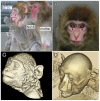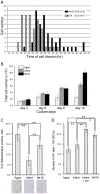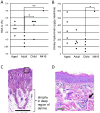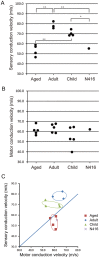Sporadic premature aging in a Japanese monkey: a primate model for progeria
- PMID: 25365557
- PMCID: PMC4218851
- DOI: 10.1371/journal.pone.0111867
Sporadic premature aging in a Japanese monkey: a primate model for progeria
Abstract
In our institute, we have recently found a child Japanese monkey who is characterized by deep wrinkles of the skin and cataract of bilateral eyes. Numbers of analyses were performed to identify symptoms representing different aspects of aging. In this monkey, the cell cycle of fibroblasts at early passage was significantly extended as compared to a normal control. Moreover, both the appearance of senescent cells and the deficiency in DNA repair were observed. Also, pathological examination showed that this monkey has poikiloderma with superficial telangiectasia, and biochemical assay confirmed that levels of HbA1c and urinary hyaluronan were higher than those of other (child, adult, and aged) monkey groups. Of particular interest was that our MRI analysis revealed expansion of the cerebral sulci and lateral ventricles probably due to shrinkage of the cerebral cortex and the hippocampus. In addition, the conduction velocity of a peripheral sensory but not motor nerve was lower than in adult and child monkeys, and as low as in aged monkeys. However, we could not detect any individual-unique mutations of known genes responsible for major progeroid syndromes. The present results indicate that the monkey suffers from a kind of progeria that is not necessarily typical to human progeroid syndromes.
Conflict of interest statement
Figures





Similar articles
-
Altered regulation of platelet-derived growth factor A-chain and c-fos gene expression in senescent progeria fibroblasts.J Cell Physiol. 1990 Aug;144(2):313-25. doi: 10.1002/jcp.1041440218. J Cell Physiol. 1990. PMID: 2166059
-
Nuclear matrix, nuclear envelope and premature aging syndromes in a translational research perspective.Semin Cell Dev Biol. 2014 May;29:125-47. doi: 10.1016/j.semcdb.2014.03.021. Epub 2014 Mar 22. Semin Cell Dev Biol. 2014. PMID: 24662892 Review.
-
Molecular bases of progeroid syndromes.Hum Mol Genet. 2006 Oct 15;15 Spec No 2:R151-61. doi: 10.1093/hmg/ddl214. Hum Mol Genet. 2006. PMID: 16987878 Review.
-
Gene expression and DNA repair in progeroid syndromes and human aging.Ageing Res Rev. 2005 Nov;4(4):579-602. doi: 10.1016/j.arr.2005.06.008. Epub 2005 Oct 24. Ageing Res Rev. 2005. PMID: 16246641 Review.
-
From the rarest to the most common: insights from progeroid syndromes into skin cancer and aging.J Invest Dermatol. 2009 Oct;129(10):2340-50. doi: 10.1038/jid.2009.103. Epub 2009 Apr 23. J Invest Dermatol. 2009. PMID: 19387478 Review.
Cited by
-
Derivation of induced pluripotent stem cells in Japanese macaque (Macaca fuscata).Sci Rep. 2018 Aug 15;8(1):12187. doi: 10.1038/s41598-018-30734-w. Sci Rep. 2018. PMID: 30111816 Free PMC article.
-
Sphere-formation culture of testicular germ cells in the common marmoset, a small New World monkey.Primates. 2016 Jan;57(1):129-35. doi: 10.1007/s10329-015-0500-4. Epub 2015 Nov 3. Primates. 2016. PMID: 26530217
-
MHC-identical and transgenic cynomolgus macaques for preclinical studies.Inflamm Regen. 2018 Nov 22;38:30. doi: 10.1186/s41232-018-0088-3. eCollection 2018. Inflamm Regen. 2018. PMID: 30479676 Free PMC article. Review.
-
International Harmonization of Nomenclature and Diagnostic Criteria (INHAND): Non-proliferative and Proliferative Lesions of the Non-human Primate (M. fascicularis).J Toxicol Pathol. 2021;34(3 Suppl):1S-182S. doi: 10.1293/tox.34.1S. Epub 2021 Sep 28. J Toxicol Pathol. 2021. PMID: 34712008 Free PMC article. Review.
-
Omics research in atherosclerosis.Mol Cell Biochem. 2025 Apr;480(4):2077-2102. doi: 10.1007/s11010-024-05139-1. Epub 2024 Oct 24. Mol Cell Biochem. 2025. PMID: 39446251 Review.
References
-
- Mohaghegh P, Hickson ID (2002) Premature aging in RecQ helicase-deficient human syndromes. Int J Biochem Cell Biol 34: 1496–1501. - PubMed
-
- Pollex RL, Hegele RA (2004) Hutchinson-Gilford progeria syndrome. Clin Genet 66: 375–381. - PubMed
-
- Hoki Y, Araki R, Fujimori A, Ohhata T, Koseki H, et al. (2003) Growth retardation and skin abnormalities of the Recql4-deficient mouse. Hum Mol Genet 12: 2293–2299. - PubMed
-
- Hirai H, Hirai Y, Kawamoto Y, Endo H, Kimura J, et al. (2002) Cytogenetic differentiation of two sympatric tree shrew taxa found in the southern part of the Isthmus of Kra. Chrom Res 9: 313–327. - PubMed
-
- Nishimura T, Oishi T, Suzuki J, Matsuda K, Takahashi T (2008) Development of the supralaryngeal vocal tract in Japanese macaques: implications for the evolution of the descent of the larynx. Am J Phys Anthropol 135: 182–194. - PubMed
MeSH terms
LinkOut - more resources
Full Text Sources
Other Literature Sources
Medical

